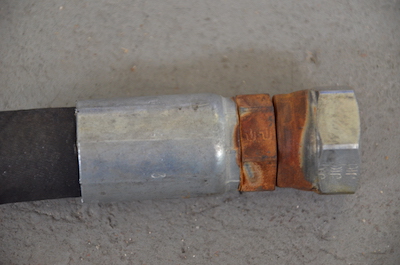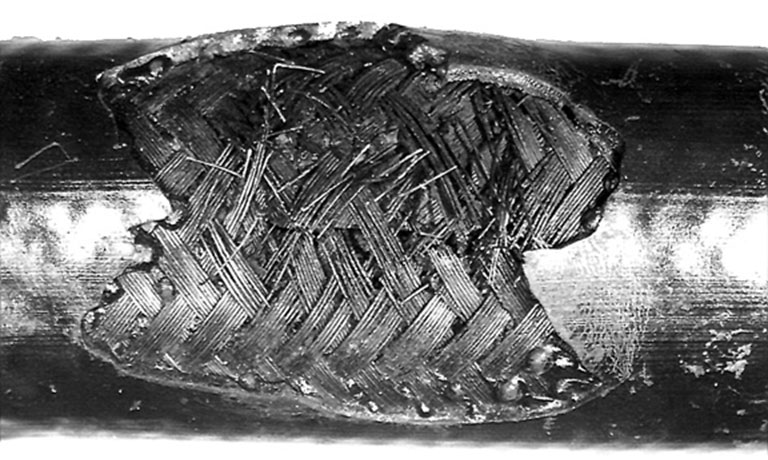Even with proper selection and installation, hose life may be significantly reduced without a continuing maintenance program. The severity of the application, risk potential from a possible hose failure, and experience with any hose failures in the application or in similar applications should determine the frequency of the inspection and the replacement for the products so that products are replaced before any failure occurs. A maintenance program must be established and followed by the user and, at minimum, must include the following actions.

1. Visual inspection of the hose and fitting — It is necessary to inspect the hose assembly regularly. If any of the following conditions are visible, the machine must be shut down immediately and the hose assembly should be replaced:
- Fitting slippage on hose;
- Damaged, cracked, cut or abraded cover (any reinforcement exposed);
- Hard, stiff, heat cracked, or charred hose;
- Cracked, damaged, or badly corroded fittings;
- Leaks at fitting or in hose;
- Kinked, crushed, flattened or twisted hose; and
- Blistered, soft, degraded, or loose cover.
2. Visual inspection of all other related hose assembly components — The following items must be tightened, repaired, corrected or replaced as required:
- Leaking port conditions;
- Excess dirt buildup;
- Worn clamps, guards or shields; and
- System fluid level, fluid type, and any air entrapment.

3. Functional test — Operate the system at maximum operating pressure and check for possible malfunctions and leaks. Personnel must avoid potential hazardous areas while testing and using the system. Ensure that hose is not operating outside of its published maximum working pressure and that surge or peak pressures are also below this point.
4. Replacement intervals — Hose assemblies and elastomeric seals used on hose fittings and adapters will eventually age, harden, wear and deteriorate under thermal cycling and compression set. Hose assemblies and elastomeric seals should be inspected and replaced at specific replacement intervals, based on previous service life, government or industry recommendations, or when failures could result in unacceptable downtime, damage, or injury risk. They may also be subject to internal mechanical and/or chemical wear from the conveying fluid and may fail without warning.
5. Hose inspection and failure — Hydraulic power is accomplished by using high-pressure fluids to transfer energy and do work. Hoses, fittings and hose assemblies all contribute to this by transmitting fluids at high pressures. Fluids under pressure can be dangerous and potentially lethal and, therefore, extreme caution must be exercised when working with fluids under pressure and handling the hoses transporting the fluids.

From time to time, hose assemblies may fail if they are not replaced at proper time intervals. Usually, these failures are the result of some form of misapplication, abuse, wear or failure to perform proper maintenance. When hoses fail, generally the high-pressure fluids inside escape in a stream which may or may not be visible to the user. Under no circumstances should the user attempt to locate the leak by “feeling” with their hands or any other part of their body. High-pressure fluids can and will penetrate the skin and cause severe tissue damage and possibly loss of limb. Even seemingly minor hydraulic fluid injection injuries must be treated immediately by a physician with knowledge of the tissue-damaging properties of hydraulic fluid.
If a hose failure occurs, immediately shut down the equipment and leave the area until pressure has been completely released from the hose assembly. Simply shutting down the hydraulic pump may or may not eliminate the pressure in the hose assembly. Many times check valves, etc., are employed in a system and can cause pressure to remain in a hose assembly even when pumps or equipment are not operating. Tiny holes in the hose, commonly known as pinholes, can eject small, dangerously powerful but hard to see streams of hydraulic fluid. It may take several minutes or even hours for the pressure to be relieved so that the assembly may be examined safely.
Once the pressure has been reduced to zero, the hose assembly may be taken off the equipment and examined. It must always be replaced if a failure has occurred. Never attempt to patch or repair a hose assembly that has failed. At this point, it requires a replacement.
6. Elastomeric seals — Elastomeric seals will eventually age, harden, wear and deteriorate under thermal cycling and compression set. They should be inspected and replaced regularly to protect the system.
Parker Hannifin, Fluid Connectors Group, Hose Division
www.parker.com

The same precautions apply to hoses used for gasses at similar pressures. The additional hazard from high pressure gas leaks is the intense noise, which may be ultrasonic and not audible, but still rapidly damaging to hearing.
Also, hose whipping from either liquid or gas can inflict major injuries .